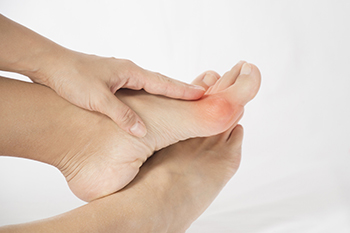
Bunions are a common foot deformity that develop when the tip of the big toe shifts toward the second toe, causing a bony bump to form on the side of the foot. This misalignment can be caused by inherited foot structure, wearing tight or narrow shoes, arthritis, or repeated stress on the joint. Symptoms often include pain, swelling, redness, and difficulty wearing shoes. The area may feel sore to the touch and can become more painful with walking or standing for long periods. Over time, bunions may worsen and affect mobility. A podiatrist can diagnose a bunion through a physical examination and X-rays to assess the severity. Treatment options include footwear changes, custom orthotics, padding, and anti-inflammatory medications. In more severe cases, surgical correction may be necessary to realign the joint. Early intervention can relieve discomfort and prevent progression. To explore effective solutions for bunion pain and deformity, it is suggested that you make an appointment with a podiatrist.
If you are suffering from bunions, contact one of our podiatrists of Foot Doctors of Utica. Our doctors can provide the care you need to keep you pain-free and on your feet.
What Is a Bunion?
A bunion is formed of swollen tissue or an enlargement of boney growth, usually located at the base joint of the toe that connects to the foot. The swelling occurs due to the bones in the big toe shifting inward, which impacts the other toes of the foot. This causes the area around the base of the big toe to become inflamed and painful.
Why Do Bunions Form?
Genetics – Susceptibility to bunions are often hereditary
Stress on the feet – Poorly fitted and uncomfortable footwear that places stress on feet, such as heels, can worsen existing bunions
How Are Bunions Diagnosed?
Doctors often perform two tests – blood tests and x-rays – when trying to diagnose bunions, especially in the early stages of development. Blood tests help determine if the foot pain is being caused by something else, such as arthritis, while x-rays provide a clear picture of your bone structure to your doctor.
How Are Bunions Treated?
- Refrain from wearing heels or similar shoes that cause discomfort
- Select wider shoes that can provide more comfort and reduce pain
- Anti-inflammatory and pain management drugs
- Orthotics or foot inserts
- Surgery
If you have any questions, please feel free to contact our offices located in Herkimer, and New Hartford, NY . We offer the newest diagnostic and treatment technologies for all your foot care needs.
